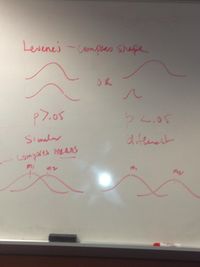Difference between pages "Histograms" and "Levene's p versus the test statistic p"
| Line 1: | Line 1: | ||
| − | + | Levene's p versus the test statistic p | |
| − | + | When an value is set at .05, any p that is smaller than .05 is producing a statistically significant different result, while any value greater than .05 is producing a statistically similar result. | |
| − | + | p≤.05 statistical difference | |
| − | + | p>.05 statistical similarity | |
| − | + | When do we want one or the other? It depends on the question asked. | |
| − | + | ||
| − | + | For example, when we are looking at two sets of data to see if they are homogenous to one another for the purpose of equal variances, we want p>.05 so there IS statistical similarity. Therefore the Levene’s test demonstrates homogeneity (equal variance) when p>.05. (This generally results in an F≈1.) When Levene’s is statistically similar this is a GOOD thing, because it gives us confidence that data sets have similar distributions (even though their means might be different). In other words, the curves look similar, even though their centers might be at different points on the number line. | |
| − | |||
| − | |||
| − | + | On a t test, you are generally trying to show a difference (although not always the case). Therefore the p≤.05. If p≤.05 then we know that tcrit<tstat. If p>.05, then tcrit>tstat. | |
| − | |||
| − | + | ''contributed by Frank LaBanca, EdD'' | |
| − | |||
| − | + | This is a great visual for 'significantly different and similar'. | |
| − | + | [[File:Statistics.JPG|200px|thumb|left|alt text]] | |
| − | |||
| − | |||
| − | |||
| + | ''contributed by John Ryan'' | ||
| + | ''drawing by Frank LaBanca, EdD'' | ||
| − | ''contributed by | + | |
| + | |||
| + | This is an informative video I found that explains Levene's Test for Equality of Variances (also known as Levene's Test for Homogeneity of Variance). | ||
| + | [https://youtu.be/4mkEZxgxMRA Levene’s Test of Homogeneity of Variance in SPSS] | ||
| + | |||
| + | ''contributed by Scott Trungadi'' | ||
| + | |||
| + | |||
| + | == Calculating the Levene's test for a t-test in SPSS == | ||
| + | |||
| + | On SPSS, go to Analyze then Compare Means. Click on Independent Samples T test. Then, choose the variable you are testing and choose the group variable. Click on definite groups and use the numbers that correlates with the two groups you are comparing. Then, you will have your Levene's p value. If the Levene's test is greater than .05, use the top row of statistics. If it is less than or equal to .05, use the bottom row of statistics. | ||
| + | |||
| + | ''contributed by Lisa Daigle'' | ||
Latest revision as of 08:37, 20 April 2022
Levene's p versus the test statistic p When an value is set at .05, any p that is smaller than .05 is producing a statistically significant different result, while any value greater than .05 is producing a statistically similar result.
p≤.05 statistical difference
p>.05 statistical similarity
When do we want one or the other? It depends on the question asked.
For example, when we are looking at two sets of data to see if they are homogenous to one another for the purpose of equal variances, we want p>.05 so there IS statistical similarity. Therefore the Levene’s test demonstrates homogeneity (equal variance) when p>.05. (This generally results in an F≈1.) When Levene’s is statistically similar this is a GOOD thing, because it gives us confidence that data sets have similar distributions (even though their means might be different). In other words, the curves look similar, even though their centers might be at different points on the number line.
On a t test, you are generally trying to show a difference (although not always the case). Therefore the p≤.05. If p≤.05 then we know that tcrit<tstat. If p>.05, then tcrit>tstat.
contributed by Frank LaBanca, EdD
This is a great visual for 'significantly different and similar'.
contributed by John Ryan
drawing by Frank LaBanca, EdD
This is an informative video I found that explains Levene's Test for Equality of Variances (also known as Levene's Test for Homogeneity of Variance). Levene’s Test of Homogeneity of Variance in SPSS
contributed by Scott Trungadi
Calculating the Levene's test for a t-test in SPSS
On SPSS, go to Analyze then Compare Means. Click on Independent Samples T test. Then, choose the variable you are testing and choose the group variable. Click on definite groups and use the numbers that correlates with the two groups you are comparing. Then, you will have your Levene's p value. If the Levene's test is greater than .05, use the top row of statistics. If it is less than or equal to .05, use the bottom row of statistics.
contributed by Lisa Daigle
